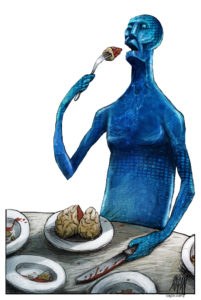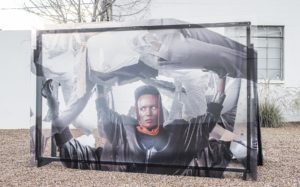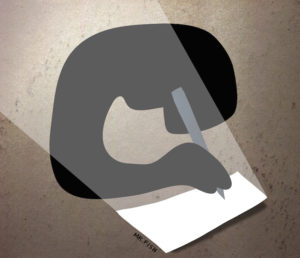A Restless Restitution in Africa
Mati Diop breathes life into statues in the ethereal political art doc “Dahomey.” A scene from “Dahomey." Courtesy of Mubi
A scene from “Dahomey." Courtesy of Mubi
Three years ago, 26 royal objects looted by French troops in the 1890s were returned from Paris’s Musée du Quai Branly to the former Kingdom of Dahomey, known today as Benin. “Dahomey” begins its slight 67-minute run time as a chronicle of the technical aspects of this restitution and the labor involved in preserving and transferring artworks that represent a fraction of an estimated 7,000 objects stolen by the French. But the film soon expands into a textured rumination about the nature of art, cultural memory and the legacy of colonialism. The ethereal docufiction won the coveted Golden Bear at Berlin and has further cemented the reputation of French-Senegalese filmmaker Mati Diop as a vital cinematic presence.
The film begins with a single wooden statue, dubbed “Number 26” by the Musée du Quai Branly, as it is carefully prepared for its journey. This enormous woodworking depicts Dahomey’s 19th-century ruler, King Ghezo, who had a complex relationship to slave trade. After the statue is gently placed in a container for shipment, it begins to speak plaintively in Benin’s Fon language, telling of its years of darkness in the corner of a French museum in a deep and echoing voice that resembles the sounds of nails being mechanically driven into its shipping crate — or a coffin.
What makes a culture? What makes a people?
The statue of King Ghezo is delivered — alongside 25 other artworks, each with their own religious or ritualistic significance — to a temporary home in Benin’s presidential palace in Abomey, occupied by current leader Patrice Talon. Diop and cinematographer Joséphine Drouin-Viallard capture both Benin’s celebratory welcome parades as well as the emotional reactions of Beninians, who are finally able to glimpse the artifacts up close, albeit behind glass. The scenes are presented in a dreamlike slow motion that seems to imbue the modern gaze with an anachronistic ritualism, a transposition that suggests a time when Benin’s ancestors looked upon these objects with awe and respect.
The story widens the moment Diop cuts to students from the University of Abomey-Calavi seated in an open-air auditorium debating the pros and cons of the restitution. Editor Gabriel Gonzalez whips between shots of participants as they deliver and react to impassioned speeches, producing a result reminiscent of the public hearing scenes in “The Godfather Part II.” Their arguments concern everything from the domestic and international political optics of the restitution, to self-reflexive observations about their national discourse on the lingering shadow of colonialism. One student points out that they are holding the debate in French.
“Dahomey” joins a growing conversation in recent years about the function of Western museums that house African culture and their obligation to return artworks to their ancestral lands. These reached as far downstream as the 2018 Marvel movie “Black Panther,” which brought debates about plundered African artworks to popular audiences. As “Dahomey” makes clear, repatriation raises complex issues not easily dealt with in a sci-fi fantasy. Although the students speak confidently, Diop’s camera lingers on them long enough to capture fleeting moments of self-doubt about the questions at the center of the film: What makes a culture? What makes a people?

The students wrestle with the ironies of a restitution overseen by the same country that stole them in the first place. Some students suggest that, by returning these 26 pieces, France is merely trying to bolster its image in a region where it continues to maintain neocolonial interests and influence. They even call into question the value of displaying them in a museum context — whether in France or Benin. These spaces not only depend on public and private patronage, but accessing them is a tall task for the majority of Benin’s citizens, whose poverty rate hovers around 40%. Pulling back the curtain further, the film observes that museums dedicated to African art (featuring objects originally meant for worship and memorialization) are themselves a Western construct. Other students make the observation that the artworks’ arrival in Benin serves Talon’s encroaching autocracy by allowing him to pose as a hero without addressing more pressing social and economies matters.
Near the film’s conclusion, Diop returns to the conscious woodworking of Ghezo. Over shots of Abomey’s nightlife, the former king muses on whether the spirit of Benin and its past can (or ought to be) contained within statues in the first place. The suggestion that culture is too ephemeral for any material representation flies in the face of what seemed to be the film’s initial premise: that physical objects contain power. This unexpected reversal turns “Dahomey” into a cinematic act of defiance, not just against the abuse of collective memory, but against the modern museum and even modern notions of art. For Diop, both represent a paradigm warranting scrutiny, if not dismantling in favor of something new.
Your support is crucial...As we navigate an uncertain 2025, with a new administration questioning press freedoms, the risks are clear: our ability to report freely is under threat.
Your tax-deductible donation enables us to dig deeper, delivering fearless investigative reporting and analysis that exposes the reality beneath the headlines — without compromise.
Now is the time to take action. Stand with our courageous journalists. Donate today to protect a free press, uphold democracy and uncover the stories that need to be told.






You need to be a supporter to comment.
There are currently no responses to this article.
Be the first to respond.